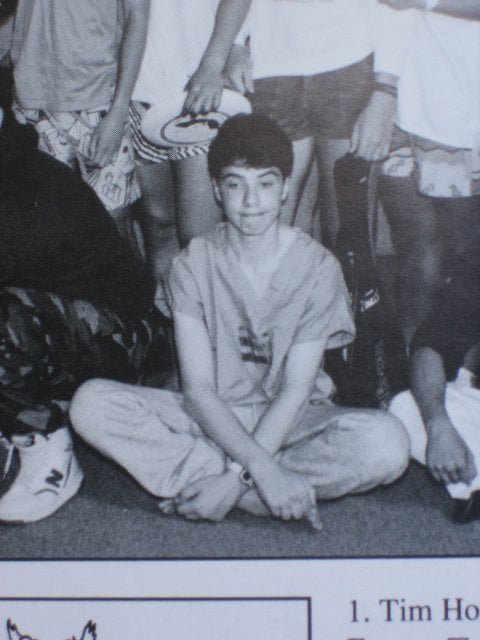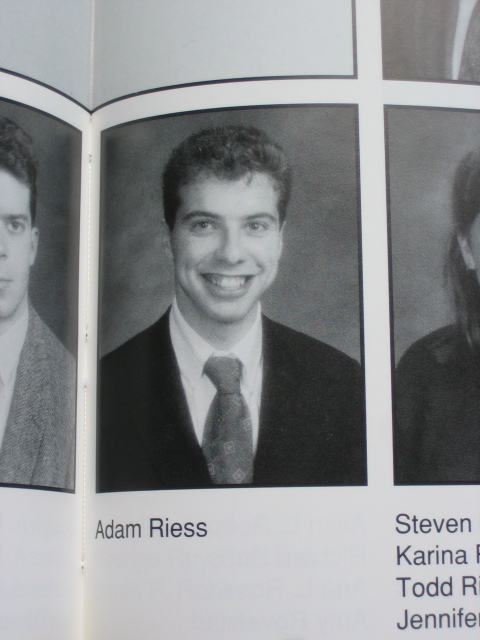MIT Alum Adam Riess ‘92 Wins Nobel Prize by Matt McGann '00
Riess was a Course 8 Phi Delt with a minor in History.
This morning, MIT alum Adam Riess ’92 won the Nobel Prize in Physics.

Adam Riess, MIT Class of 1992, Nobel Laureate in Physics 2011
Riess, who is just 41 years old, shares the prize with fellow researchers Saul Perlmutter and Brian Schmidt for “the discovery of the accelerating expansion of the Universe through observations of distant supernovae.” He is the 77th MIT-connected winner of the Nobel Prize.
My favorite quote from Riess about the Nobel comes from the Associated Press story:
Riess, 41, said he got a phone call around 5:30 a.m. Several Swedish men were on the line, at which point he “knew it wasn’t Ikea,” the Swedish furniture retailer. His “jaw dropped” when he heard the news, he said.
Adam Riess’s journey to the Nobel Prize began long ago. Born in Washington, DC, he attended Watchung Hills Regional High School in Warren, New Jersey. After graduation, Riess chose to attend MIT, where he majored in Physics (Course 8).
As an MIT student, Riess joined the Phi Delta Theta fraternity and lived in the Phi Delt house on Bay State Road in Boston, near Kenmore Square and Fenway Park. The Phi Delts have a beautiful house overlooking the Charles River; it was originally built as a mansion for the Lieutenant Governor of Massachusetts in 1902.

Adam Riess as a freshman at MIT, as pictures in the Phi Delta Theta 1989 yearbook photo.
In addition to his major in Physics, Riess also picked up a minor in History. According to a Johns Hopkins Magazine story, capped off his history minor by writing “a final research paper on baseball’s 1919 ‘Black Sox’ scandal. He investigated whether the Chicago White Sox’s effort to throw the World Series that year could be deduced from news reports and box score statistics. (The answer: It couldn’t.)”
Riess also met his wife, Nancy, at MIT. Nancy was a Materials Science major, and, like Adam, was interested in the humanities, being named a Burchard Scholar. She was a member of the Alpha Chi Omega sorority and participated in the Concourse Program.

Adam Riess in his MIT senior yearbook photo.
Riess graduated with a 4.94 GPA (on the MIT 5.0 scale) and was named to Phi Beta Kappa. He then went on to graduate school at Harvard, where he received his Ph.D. in 1996 in Astrophysics, then a Postdoctoral Fellowship at Berkeley, then joined the Space Telescope Science Institute. He was appointed a full professor at Johns Hopkins in 2006. Aside from the Nobel Prize, Riess has also won a MacArthur “Genius Grant” Fellowship, the Shaw Prize, the Einstein Medal, and is a member of both the American Academy of Arts and Sciences and the National Academy of Sciences.
Here is the release from the Nobel Prize about this year’s award:
Written in the stars
“Some say the world will end in fire, some say in ice…”
What will be the final destiny of the Universe? Probably it will end in ice, if we are to believe this year’s Nobel Laureates in Physics. They have studied several dozen exploding stars, called supernovae, and discovered that the Universe is expanding at an ever-accelerating rate. The discovery came as a complete surprise even to the Laureates themselves.
In 1998, cosmology was shaken at its foundations as two research teams presented their findings. Headed by Saul Perlmutter, one of the teams had set to work in 1988. Brian Schmidt headed another team, launched at the end of 1994, where Adam Riess was to play a crucial role.
The research teams raced to map the Universe by locating the most distant supernovae. More sophisticated telescopes on the ground and in space, as well as more powerful computers and new digital imaging sensors (CCD, Nobel Prize in Physics in 2009), opened the possibility in the 1990s to add more pieces to the cosmological puzzle.
The teams used a particular kind of supernova, called type Ia supernova. It is an explosion of an old compact star that is as heavy as the Sun but as small as the Earth. A single such supernova can emit as much light as a whole galaxy. All in all, the two research teams found over 50 distant supernovae whose light was weaker than expected – this was a sign that the expansion of the Universe was accelerating. The potential pitfalls had been numerous, and the scientists found reassurance in the fact that both groups had reached the same astonishing conclusion.
For almost a century, the Universe has been known to be expanding as a consequence of the Big Bang about 14 billion years ago. However, the discovery that this expansion is accelerating is astounding. If the expansion will continue to speed up the Universe will end in ice.
The acceleration is thought to be driven by dark energy, but what that dark energy is remains an enigma – perhaps the greatest in physics today. What is known is that dark energy constitutes about three quarters of the Universe. Therefore the findings of the 2011 Nobel Laureates in Physics have helped to unveil a Universe that to a large extent is unknown to science. And everything is possible again.
Congratulations, Adam Riess! We look forward to seeing you on campus in two weeks when you deliver the Pappalardo Distinguished Lecture in Physics (Thursday, October 20, at 4:15pm in Room 10-250).
What a boss. :D
Congratz to him!
Congratulations to Mr.Adam Riess for this achievement.
Amazing!! I was just watching his videos on YouTube a few days ago. It’s amazing the way humble people do great at Science
41? Another young Physics laureate. Last year it was Novoselov and Geim at 36 and 52..
Please MATT answer this question>If you are a student in the top three of your class with mostly As on your high school transcript,a good number of extracurricular activities,excellent awards,great SAT scores, but have C grades on your external results(CBSE) due to the number of external exams you took(say,14 different subjects instead of 7),will you have a chance of getting into MIT
an enquiry:
i want to pursue economics for my graduation from my sloan?
do i still have to give test in science?(SAT)
Congratulations to both Riess and MIT. So, I guess this makes MIT’s Nobel prize years one more to ninteen! Proud of MIT!
Lot’s of congrats to you.
19 is now the number of years in a row that the Nobel Prize has been awarded to either an MIT alum or MIT faculty! It’s now 77 total for MIT Nobel Prize winners: http://web.mit.edu/ir/pop/awards/nobel.html –> it might become 78 next week when another MIT-alum win the Nobel Prize in Economics
I have predicted this will happen last week on my Facebook before the Nobel Prize was announced!!!
Beloved mascot of MIT,
Tim the Beaver